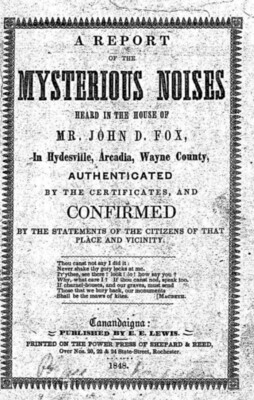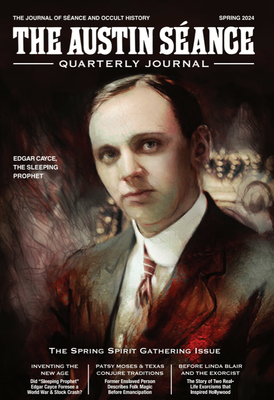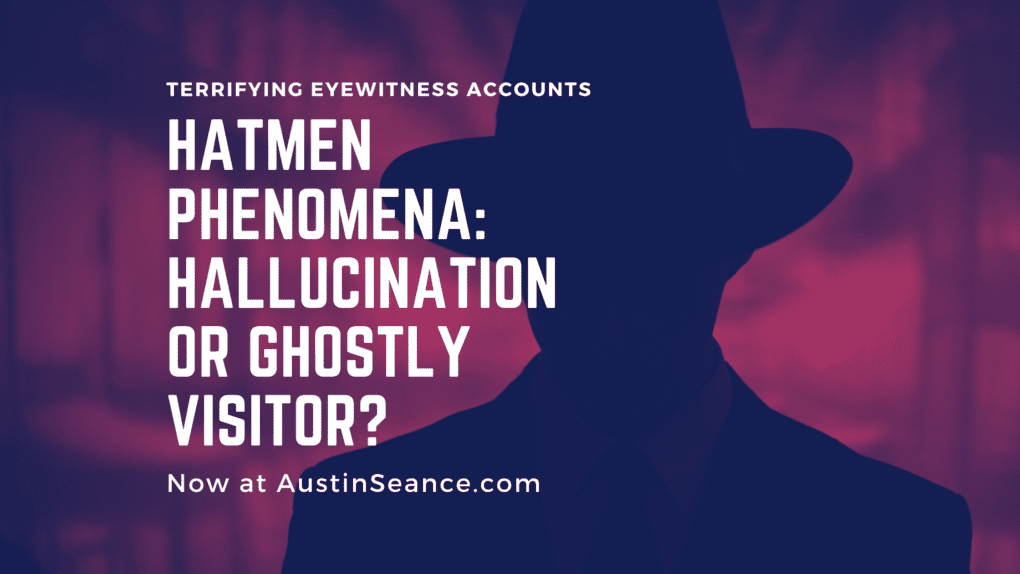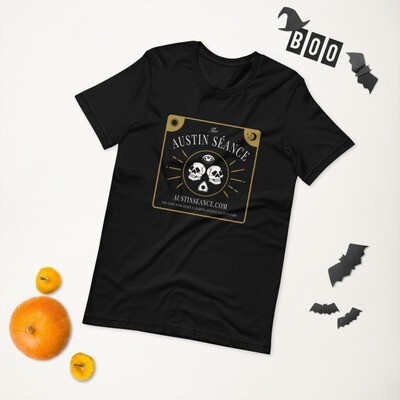by Jake Cordero
For The Austin Séance
In this installment of The Austin Séance blog we explore an exceedingly odd but widely documented phenomenon known as the “Hat Man” apparition. Witnesses say these weird apparitions typically have no discernible face, no visible eyes, no distinct features of any kind except for one — they wear hats.
 One such apparition appeared to me, years ago. But I’m by no means alone. We describe here other stories, including that of Stacy Alejos, who claimed to have spotted a Hat Man outside her San Antonio home. We also check in with the experts. How do hat men stories relate to sleep paralysis, a medical condition? We also will touch upon similar stories from other cultures. All this — as well as recent separate postings on this website — is in anticipation of a podcast Albert and I are working on. So stay tuned!
One such apparition appeared to me, years ago. But I’m by no means alone. We describe here other stories, including that of Stacy Alejos, who claimed to have spotted a Hat Man outside her San Antonio home. We also check in with the experts. How do hat men stories relate to sleep paralysis, a medical condition? We also will touch upon similar stories from other cultures. All this — as well as recent separate postings on this website — is in anticipation of a podcast Albert and I are working on. So stay tuned!
Two Texas Stories
Let’s start with Stacy Alejos’s story. Speaking to a reporter in 2019, the Texas resident recalled seeing a hat man decades ago when she was still a young girl. She shared a bedroom then with her aunt and recalled that some vague movement or possibly a sound had startled her awake. This was followed by a sudden sense of cold dread accompanied by an odd compulsion to peek out the bedside window.
This is what Stacy saw, as described in a report published in the San Antonio Current:
“As her eyes adjusted to the darkness, Stacy could clearly make out the outline of a humanoid figure standing behind the white picket fence that surrounded her yard. As Stacy watched fearfully, the being began to sidle in a strange sideways motion, all the while keeping its outstretched arms on the top fence post.
“When she noticed the audible crunching of dried leaves beneath the entity’s feet, Stacy was quite sure that she was not dreaming, nor imagining things. Understandably terrified, the young girl dove underneath her sheets, quaking in fear until morning. Her adamant attempts to wake her aunt, who was sleeping next to her at the time, were futile. It almost seemed as if her aunt had been in a trance.”
A quick search of the Internet reveals similar sightings across the country and even abroad. In every telling, the mysterious specters come at night, they wear hats and they often wear trench coats or dark suits but otherwise lack distinct features. The visitors typically appear as male figures, and it seems that young children most often experience the visitations.
Witnesses report the apparitions evoke a sense of helpless terror. This, also, is how I experienced the phenomenon. In my case, however, I saw two hat men. I was a kid, probably not yet having celebrated my 7th birthday, and living in Houston. As with Stacey Alejos’s story, I had been sleeping and at some point during the middle of the night something startled me awake. As soon as I opened my eyes I spotted two menacing male figures at the foot of my bed. One was tall and thin and the other was short and squat. Both wore bowler hats and men’s suits or trench coats. The tall one’s hat seemed exceedingly too small for his head. Neither man made a sound — they just both seemed to be watching me. But then they started reaching down, into my bed, retrieving something — what, I couldn’t say. Terrorized, I could neither move nor scream. I shut my eyes and reopened them and finally forced myself to flee past the men and into my parents’ room.
MORE ACCOUNTS
Here are two other eye-witness accounts among many that can be found in magazine articles and elsewhere:
- In 2018, Quartz magazine reported the story of 14-year-old Tim Brown, who saw a Hat Man one night after a strange noise emanated from his television startled him awake. “And that’s when he saw him,” reported the magazine. “The dark figure of a man, as featureless as the shadows where he stood. He was tall. He wore a broad-brimmed hat and a trench coat. He didn’t say a word. He didn’t need to. The fear sucked the breath from Brown’s chest, rendering him mute and immobile. The man lingered just outside the frame of Brown’s bedroom door, flickering in the shadows.”
- Another eyewitness, in an interview with the Hat Man project website, described a man in a wide-brimmed hat and black trench coat. “I remember seeing what I have now come to believe was the Hat Man back in 1971 when I was 6 years old. I slept in a room by myself and one night I woke. I had no idea as to what the time was, but knew it had to have been in the wee hours of the morning. I woke to the presence of something in my room. When I looked up there was a man standing next to my bed, right by me, only inches away and looking down at me. I couldn’t see his face. It was just black. He had on a black wide brim hat and a long black trench coat. He just stood there. I was terrified. I quickly pulled the covers over my head. My heart racing I recited the Lord’s Prayer in my head as I was too afraid to speak. It took me a few minutes to pick up the courage to peak out but when I did he was gone.”
SCIENTIFIC EXPLANATIONS?
The memory of my own experience never left me. The memory, in fact, is one of my earliest. But I never much thought about it during later years, not until I stumbled across that article from Quartz Magazine, referenced above, and recognized the similarity in the stories described in it to my own.
Experts cited in Quartz and elsewhere dismiss the phenomena as mind tricks, as hallucinations that occur during that twilight period between wakefulness and sleep. They explain that the brain shuts off the body’s motor controls during the period of active dreaming in order to protect the dreamer from harming themselves by moving around unconsciously. This has a paralyzing effect, and, according to this explanation, it’s during these periods of immobility that the hat men appear. This also explains the sense of helplessness. The subject of the hat men’s nighttime visits can neither flee or fight — two basic evolutionary responses — because they are overtaken by sleep paralysis.
Medical experts likewise say that the visitations might not be dreams, per se, but rather waking hallucinations that occur during that twilight period between wakefulness and sleep. That is, those who experience the Hat Man phenomenon are experiencing “hypnagogic hallucinations,” which Quartz describes as “vivid images perceived in the transition from wakefulness to sleep, or the other way around.”
This all seems plausible, and yet fails to explain why so many witnesses describe similar figures: dark suited men wearing hats. A psychology professor quoted in the Quartz magazine article, Christopher French from the University of London, speculated that the explanation may lie in popular culture. He notes that the horror film A Nightmare on Elm Street has entered into the popular consciousness, and that the hatted figure may well represent a variation of Freddy Krueger, the hatted villain of the film that appears in dreams.
This, however, makes no sense at all. Many of the reported visitations (including my own) occurred before the film’s release. Also, as we detail below, reports of terrifying night-time visitations appeared to have inspired the film — as opposed to the other way around.
OTHER VARIATIONS

We can look further back — into history and into folk culture — to find similar stories. One such is Germany’s “nachtmahr,” a malevolent female horse that supposedly arrives at night to prey upon sleepers. (“Nachtmahr” apparently is the source for the English word “nightmare.”) The people of France, Denmark, Iceland and Norway also tell such stories as part of their cultural traditions. Other stories include that of the Old Hag (Ag Rog) from Newfoundland; the uqumangirniq of the Canadian Inuit; the kanashibari of Japan; the sexualized Incubus and Succubus from ancient Mesopotamia; and the apuku (gnome) and jorka (ancestor) from Surinam. As noted by medical anthropologist Shelley Adler, author of Sleep Paralysis: Night-mares, Nocebos, and the Mind-Body Connection, “The entity has stalked human beings throughout history, not merely within a particular society or during a specific time.”
And lest you think these visitors are all harmless, consider for a moment the stories of the “dab tsog” of Southeast Asia. Pronounced “da cho,” these supposedly evil entities are said to smother hapless victims by pressing on their chests while they sleep. These beliefs remain fairly common to this day — including among Hmong refugees in the United States — and have been the subject of study by scientific researchers.
For instance, some years back a large group of Hmong recounted to California researchers how they had received personal visits from the dab tsog. What had prompted this scientific inquiry were deaths among the refugee community — 18 otherwise healthy Hmong in California had died unexpectedly in their sleep. The deaths had occurred during the 1970s and 1980s. Another hundred or so Hmong died under similarly mysterious circumstances during the 90s. Almost all the deceased refugees were men, none had complained of feeling ill before going to bed, and yet … they died in their sleep. Was the dab tsog to blame?
Medical professionals have pointed to heart disease as the possible culprit, perhaps combined with the stress of isolation that comes from living in a foreign land. Many of the refugees, however, blamed evil spirits.
A NIGHTMARE ON ELM STREET
Counter-intuitively, these tragic deaths among Hmong men also bring us back full-circle to consideration of A Nightmare on Elm Street, Hollywood’s most famous film about evil nightmare visitors. Director Wes Craven said that the Hmong deaths were what had inspired him in the first place. “It was a series of articles in the LA Times; three small articles about men from South East Asia, who were from immigrant families and had died in the middle of nightmares,” Craven told a reporter for Cinefantastique magazine, explaining how he had come up with the idea for his 1984 hit film.
Recall that psychology professor Christopher French had speculated that Craven’s movie — and the impression it has had on America’s popular consciousness — may explain why so many people tell very similar stories about Hat Men manifestations. But Craven’s account presents for us a chicken-and-egg quandary: did the film inspire these terrifying reports, or is the truth the other way around?
What Craven also might not have known is that these strange sleeping deaths occur so frequently in the Philippines, Thailand and Laos that some medical professionals in those countries have a name for the phenomena: “nightmare death syndrome.” Doctors in the U.S. employ a similar term: SUNDS, or “sudden unexpected nocturnal death syndrome.” U.S. doctors have speculated that an underlying heart condition combined with culture-shock related stress may explain SUNDS among America’s Hmong refugees. But whether visions of terrifying hatted men also appeared before them as their hearts seized in their chests — no one can say.
Stay tuned in 2021 for The American Séance podcast — with more about Hat Men, Dream Books, and other strange bump-in-the-night reports.
Welcome to The Austin Séance merch page. Please notice that shipping charges vary, with less expensive shipping for the talking boards and books that we handle ourselves in Austin. The Austin Séance re-invests 100 percent of net proceeds from merchandise to pay guest writers and artists.










